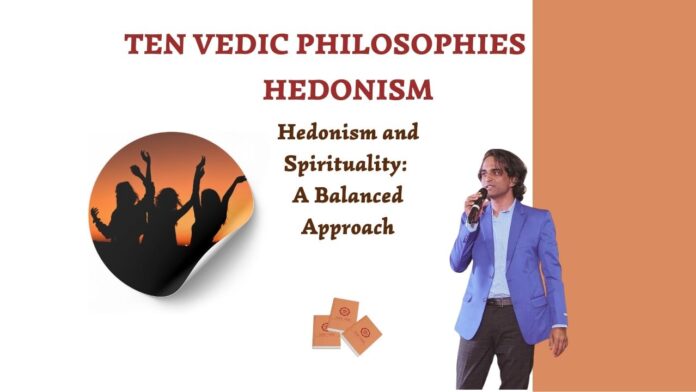Can enjoying worldly pleasure be a spiritual practice?
In the previous article, we discussed compatibilism and in this article, we will discuss hedonism.
Hedonism is a philosophical view that suggests human behaviour is primarily motivated by the desire for pleasure and the avoidance of pain. It is traced to Greek philosopher Epicurus who famously said “Pleasure is our first and kindred good. It is the starting point of every choice and of every aversion…”.
However, many religious and spiritual traditions view pleasure as an obstacle to spiritual enlightenment.
In this article, we’ll explore how the desire for happiness and the quest for spiritual enlightenment can work together, even though they might seem like opposites.
Hedonism in Indian Tradition
Charvaka: A radical form of hedonism, the Charvaka philosophy rejected the Vedas and embraced sensual pleasures without spiritual considerations. The famous quote “Yavat jivet sukham jivet, rinam kṛtva ghṛtam pibet,” says “as long as you live, live happily, even if it means going into debt to drink ghee”. However, Charvaka thought did not gained traction as a main-stream Darshana / philosophy – due to the influence of great scholars & thinkers in Vedic tradition.
Vedic Spirituality: Vedic traditions, while acknowledging the importance of worldly pleasures, emphasize a balanced approach. The Brahmana texts of Veda, for instance, describe rituals that offer both worldly and spiritual benefits. The Sri Rudram, a significant Vedic text, enumerates various desires, including material possessions and sensory pleasures, but ultimately prioritizes spiritual attainment.
Ashvamedha: The famous Ashvamedha Yajna was performed by kings for expansion of territories. Similarly, many Yajna were performed for other worldly and heavenly pleasures. Though these apparent Hedonism is at work, their spiritual meanings are explained within the Vedic scriptures itself; e.g. Shatapatha Brahmana. At the end of the said Brahmana text, we find Brihadaranyaka Upanishad. The very Upanishad starts by saying “the head of the sacrificial horse is the dawn, its eye the sun, its vital breath the wind, its open mouth the Vaisvanara fire and the trunk of the sacrificial horse is the year.” While apparently rituals are centred around Hedonism, ultimately they are aimed at achieving a higher conscious state of observing every phenomenon at cosmic level. It explains worshiping the cosmic consciousness “Virat Purusha” using the symbolism of Ashvamedha.
Chamaka: Krishna Yajurveda’s Taittiriya Samhita contains two chapters which are called “Sri Rudram”. 5th chapter is called “namaka” and 6th chapter is called “chamaka”. The Chamaka appeals to Lord Rudra to grant many worldly things one wants in life. These benedictions start with vaja-food, prasava-permission to consume it, prayati-its auspiciousness, prasiti-appetite and goes on to about 36 such requests in the first segment. It acknowledges both material and spiritual desires and requests Lord Rudra for both. For example, in the first segment itself, it requests for svara-proper intonation to chant Veda, suva-heavenly adobe …etc. Chamaka can be viewed as Hedonism at its best, but it is also aimed ultimately towards spiritual growth.
Vedanta and Hedonism
Transcending material pleasure: Vedanta acknowledges that human beings are naturally drawn to sensory experiences and that complete asceticism is not a practical or necessary path for everyone. Rather than condemning material pleasures, Vedanta encourages us to transcend them by transforming them into acts of worship.
Spiritual Yajna: Apparent hedonic actions are turned into acts of worship by performing various spiritual yajna. These yajnas aren’t just formal religious ceremonies; they are everyday actions imbued with spiritual significance. For instance, in Vaishwanara Yajna the act of eating is transformed into a spiritual offering. By offering food with gratitude and awareness, we acknowledge the divine presence within ourselves and the universe. This transforms a mundane act into a sacred ritual, elevating our consciousness and connecting us to the divine.
Framework of “dharma”: Vedanta and Dharma Shastras outline four life goals: Dharma (righteousness), Artha (prosperity), Kama (pleasure), and Moksha (liberation). The first three, the “trivarga,” are interconnected, with Dharma as the guiding principle; Moksha, the “apavarga,” is pursued independently. Thus, Vedic tradition integrates worldly pleasure within a framework of ethical conduct, rather than rejecting it.
A Balanced Approach
Vedic tradition suggests a balanced and moderate approach to hedonism. By actively pursuing happiness and turning it into a spiritual practice, we can integrate pleasure into our spiritual journey. This approach, inspired by Vedantic principles, allows us to enjoy life’s pleasures without becoming attached to them.
Key Takeaways:
Do not reject worldly pleasure: Hedonism and spirituality are not mutually exclusive. One need not feel guilty for enjoying worldly pleasure, but one has to ensure that it is within the framework of “dharma”.
Worship of almighty: A balanced approach to pleasure certainly enhances spiritual growth. One should learn to turn all pleasurable action into a worship of almighty. Without this balanced approach, these actions bind individuals to the cycle of life & death. With this balanced approach, one can transcend this cycle and attain liberation.
Start with simple Yajna: Vedic traditions offer a framework for integrating hedonistic elements into spiritual practices. You can start with the simple practice of “Vaishwanara Yajna” and progress to performing other spiritual practices.
One should remember that by transforming worldly pleasures into spiritual offerings, we can cultivate a harmonious and fulfilling life, both material and spiritual.
In the next article, we will discuss the philosophical idea “Epistemology”.
Madhwesh K
Vedic Tribe

